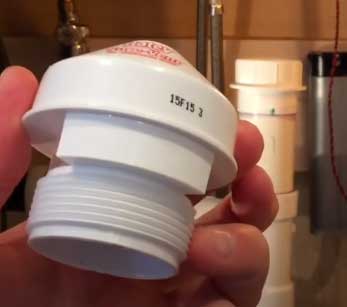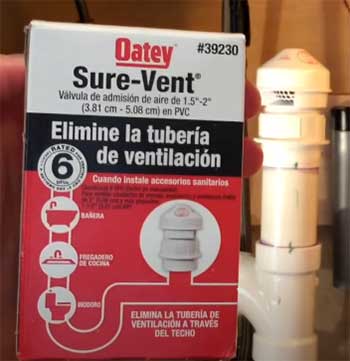Oatey sure vent air admittance valves are a popular option for venting plumbing fixtures where traditional pipe venting is difficult or impossible. However, like any plumbing product, sure vents can malfunction or fail over time.
This article will provide a comprehensive overview of diagnosing and resolving the most common Oatey sure vent problems.
What Is An Air Admittance Valve?
Before diving into troubleshooting, let’s quickly review what exactly a sure vent does. An air admittance valve (AAV), sometimes called a Durgo valve, is a one-way mechanical venting device designed to prevent siphonage and backflow in drain lines.
AAVs allow air to enter the plumbing vent system to maintain proper air pressure within drain lines. This equalizes the pressure and allows wastewater to flow freely down the drain. Without proper venting, you may experience gurgling noises, slow draining fixtures, or even complete clogs.
Oatey sure vents are designed to be installed instead of traditional pipe venting in situations where structural issues prevent running vent stacks through the roof. Common applications include island sinks, basement bathrooms, and remote fixtures.
Diagnosing Sure Vent Issues
Many of the problems caused by a faulty sure vent mimic traditional venting problems. Here are some of the most common signs of sure vent failure:

- Gurgling noises from drains – A lack of proper air flow will cause bubbly, gurgling drain noises as wastewater exits the trap. This is one of the most obvious indicators of venting issues.
- Slow draining fixtures – Drains that seem to take forever to empty often point to venting problems. Without air flow, siphoning action cannot take place properly.
- Intermittent clogs– Partial clogs that seem to fix themselves point to situations where venting is allowing just enough air flow for water to drain slowly. Fixtures may work sometimes but not others.
- Sewer gas odors – Because AAVs only allow air to enter, smells from the sewer system can backflow into the home when they fail. Bad venting is a very common source of rotten egg and sewage odors.
- Plumbing leaks – Inadequate venting can result in excess pressure in the drain system that leads to leaks at joints and connections. This is especially common after heavy drainage events when lots of water is entering the system rapidly.
- Pilot light outages – Appliance pilot lights can be extinguished by negative air pressure resulting from poor venting. This is an issue most common in furnaces, boilers, and water heaters that rely on standing pilot lights.
Any of these symptoms point to potential sure vent failure or another venting issue in the system.
Inspecting the Sure Vent Device
Once you suspect an issue with the air admittance valve itself, it’s time to locate it and inspect the unit. Oatey sure vents should be installed as close as possible to the fixture they are venting according to plumbing code. Most often, you’ll find them behind a sink mounted to the wall or cabinet face.
Removing the cover panel provides access to the device for inspection. Here’s what to look for:
- Obstructions – Check that the vent opening itself is clear of any debris, dust, or other obstructions. Even small blockages can restrict air flow.
- Damage – Inspect for any physical damage to the valve mechanism or body. Cracks or leaks mean it’s time for a replacement.
- Moisture – Excess moisture inside the unit can impede operation. A small amount is normal, but standing water indicates a problem.
- Movement – Verify that the internal float and flap mechanism is still able to move freely to operate the valve. Mineral deposits or other buildup can seize the assembly over time.
- Sealing – Make sure the gasket is still in good shape and sealing properly. Damage here can allow the valve to suck in sewer gas instead of fresh air.
Testing Air Admittance Valve Function
To confirm the sure vent is actually failing to open and allow air flow, a simple test can be performed:
- Remove the valve cover and observe the position of the internal float. It should be down allowing the flap to close.
- Pour a small amount of water directly into the sure vent. You should immediately see the float rise and the flap open.
- Once you’ve verified movement, blow gently across the opening. This should allow air to pass through while preventing any backflow of odors.
If water does not cause the float mechanism to open, or air cannot pass through the valve, the unit has failed and must be replaced. Caution should be taken not to introduce any water into the valve opening in excess amounts, as this can lead to leaks and water damage behind walls.
Troubleshooting the Drainage System
While sure vent failure is certainly a possibility, other drain problems can produce similar symptoms. Here are some things to inspect in the rest of the plumbing system before assuming the air admittance valve is the sole issue:

- Main vent blockage – Even if you have a sure vent installed, traditional venting is likely still used elsewhere in the home. Roof vents and main stacks can become blocked and disrupt airflow.
- Clogged fixtures – Partial clogs in drains and traps will impede drainage and limit air flow throughout the system. As a general maintenance practice, visually inspect all drains and overflow holes.
- Bellies in pipes – Low spots and sags in drain lines can collect debris and water leading to reduced flow and gurgling/bubbling. Feel along horizontal runs for any noticeable bellies.
- Undersized drain lines – When drainage load is too high for the existing pipe capacity, venting issues will occur as water rapidly fills the pipes. This is most common after renovations or additions to the home.
- Non-vented fixtures – Things like washing machines, floor drains, and condensate pumps are sometimes tied into the drain system without proper venting accommodations.
Take the time to thoroughly inspect the drainage system before assuming the issue lies solely with the sure vent device itself. Homeowners can snake accessible drains and use drain cleaners to clear any obstructions prior to replacing a faulty air admittance valve.
Replacing a Bad Sure Vent
Once you’ve confirmed through testing and inspection that the Oatey sure vent unit has failed, replacement is required to restore proper venting in the plumbing system. Follow these guidelines for a smooth air admittance valve installation:
Materials Needed
- New air admittance valve (match size and type of original)
- PTFE plumbing tape
- Adjustable wrench
- Rag
- Drill and hole saw (if enlarging mounting hole)
Installation Steps
- Turn off the water supply and drain the fixture completely.
- Disconnect any hoses or supply lines. Removing the sink may help access.
- Unthread the sure vent from the drain pipe. A large adjustable wrench allows you to unscrew the fitting.
- Thoroughly clean the drain pipe end and remove any old tape or putty.
- Wrap the male threads on the new air admittance valve with several layers of PTFE tape.
- Thread the new sure vent onto the drain pipe. The valve should be upright and positioned at least 4” above the sink flood rim.
- Re-install the sink if removed and reconnect supply lines. Check for leaks.
- Turn water supply back on and test for proper operation by running water into the sink and observing smooth, gurgle-free drainage.
Let’s watch the installation video to make it easier.
With a properly functioning replacement air admittance valve installed, your troublesome venting issues should be resolved. Be sure to clean and maintain all drains and overflows to prevent future blockages as part of regular plumbing system care.
Preventing Sure Vent Problems
Like any other plumbing component, proper maintenance and care is key to maximizing the lifespan of your Oatey sure vent. Here are some proactive steps you can take to avoid problems down the road:
- Clean debris from the valve inset – Periodically wipe away any dust/debris from the valve opening using a small brush or pipe cleaner.
- Flush with hot water – Run very hot water down the drain monthly to clear any buildup and keep things flowing freely.
- Clear overflows – Clean sink overflows to allow air to enter the drain system. Clogged overflows can negate the effectiveness of a sure vent.
- Watch for leaks – Detecting and repairing even small leaks quickly will keep moisture away from the valve internals.
- Insulate pipes – Insulating exposed drain pipes can reduce condensation buildup that leads to gunk accumulation.
With proper installation and regular maintenance, an Oatey sure vent should provide decades of reliable, code-approved venting for your plumbing system.
Frequently Asked Questions About Sure Vent Issues
The most common symptoms of a failing air admittance valve like the Oatey Sure Vent include gurgling sounds from drains, slow draining fixtures, foul sewage odors, plumbing leaks, intermittent clogs, and pilot light issues.
Inspect for visible damage, obstructions, moisture accumulation and ensure the float/flap mechanism moves freely. Test operation by pouring water into the valve to observe opening and blowing air to confirm flow. Issues like excessive gurgling/bubbling from drains and slow drainage also indicate venting problems.
Start by inspecting the physical condition and operation of the air admittance valve itself if present. Flush drain lines and snake/clean all fixtures to rule out clogs. Feel for bellies or sagging pipes that could impede drainage. Also look for disconnected or non-vented fixtures tapped into the drain system. Isolate the source of the problem prior to replacing components.
First address any blockages or obstructions in the drain system itself. Replace failed air admittance valves or clear debris from conventional vents. You may need to resize undersized drain lines to allow adequate airflow for proper venting function. In some cases, adding vents for non-vented appliances or rerouting to main vent stacks solves persistent issues.
Regular maintenance like clearing debris from the valve opening, running hot water through the drain, and keeping overflows clear of blockages will maximize the lifespan of your sure vent. Checking for leaks near the valve and insulating drain pipes are also wise preventative steps to take. Test the operation annually by pouring water into the valve to confirm proper float activation.
Closing Remarks
Like any other mechanical plumbing component, Oatey’s popular sure vent air admittance valves can eventually fail or malfunction. Familiarizing yourself with the common symptoms of a faulty unit and utilizing testing procedures will allow you to zero in on these valves as the cause of ongoing venting issues.
Replace defective or damaged sure vents promptly to restore proper airflow and drainage. Include regular maintenance of your valve and drain system into routine plumbing care.
With a properly functioning air admittance valve and clear drain lines, your vents should operate problem-free for years to come.
